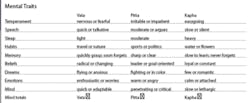Know your dental dosha
My dear friends Michelle Hurlbutt, RDH, and Kristy Menage Bernie, RDH, from California and I have studied and developed courses on the mind, body, and spirit. One of our favorites is “Know Your Dental Dosha.” Our goal for the course and this column is for you to discover your dosha and understand how it can affect the dynamics and interpersonal communications in your dental workplace.
Ayurveda is India’s 5,000-year-old “Science of Life.” Simply put, it is the art of living in harmony with nature. The Ayurveda studies people’s physical and psychic behavior and prescribes ways for them to synchronize with their environment to live happy, healthy, and inspired lives. Much emphasis in Ayurveda is on diet, following the cycles of the seasons, getting up before dawn, massage, and other practices. Your dosha is your mind and body type. There are three doshas in Ayurveda: Vata, Pitta, and Kapha. (No, not the Nina, Pinta, and Santa Maria as my friend calls them.) Everyone has all three doshas in their physiology in different proportions, so each person’s dosha is unique, similar to a fingerprint. When I began studying the three doshas, my skeptical self concluded they were skinny, fatty, and “I don’t give a rip.”
Vata
Vata-type people are generally thin and find it hard to gain weight. Because of this, Vatas have very little energy reserve, tire easily, and get out of balance. Vatas need to get sufficient rest, not overdo things, stay warm, and keep a regular lifestyle routine.
The Vata dosha controls all movement in the body, including breathing, digestion, and nerve impulses from the brain. When Vata is out of balance, anxiety and other nervous disorders may be present. Digestive problems, constipation, cramps, and even premenstrual pain are usually attributed to a Vata imbalance.
The most important thing to know about Vata is that it leads the other doshas. It is the key dosha. Without Vata, the other doshas cannot move. Vata brings the air or wind beneath their wings. Vata usually gets out of balance first, which causes the early stages of disease. More than half of all illnesses are Vata disorders. Balancing Vata is important for everyone, because when Vata is in balance, Pitta and Kapha are generally in balance as well.
Pitta
Pitta-type people are usually of medium size and well proportioned. They have a medium amount of physical energy and stamina. They also tend to be intelligent and have a sharp wit and a good ability to concentrate. Fire is a characteristic of Pitta, whether it shows up as fiery red hair or a short temper. Since Pittas’ body temperature is generally warm, Pitta types can get out of balance with overexposure to the sun. Their eyes are sensitive to light. They are ambitious by nature but can also be demanding and abrasive.
Pitta types are known for their strong digestion but should be careful not to abuse it. Their heat makes them particularly thirsty, and they should take caution not to douse their agni, or digestive fire, with too much liquid during meals. Pitta dosha leads us to crave moderation and purity. We rely on Pitta to regulate our intake of food, water, and air. Any toxins, such as alcohol or tobacco, show up as a Pitta imbalance. Toxic emotions such as jealousy, intolerance, and hatred also should be avoided to keep Pitta in balance for optimum health.
Kapha
Kapha-type people tend to have sturdy, heavy frames, which provide a good reserve of physical strength and stamina. Those of you who know me or have heard me speak can guess this is my dosha. Shall I repeat the heavy frame part? Thank you to Grandma Edna and my Czechoslovakian heritage. This strength gives Kaphas a natural resistance to disease and a generally positive outlook on life. The Kapha dosha is slow, and Kapha types tend to be slow eaters with slow digestion. They also speak slowly. They are calm and affectionate but, when out of balance, they become stubborn and lazy. They learn slowly, with a methodical approach, but also retain information well and understand it.
Kapha dosha controls the moist tissues of the body, so a Kapha imbalance may show up as a cold, allergies, or asthma. This is worse in Kapha season, which is March through June. Cold and wet weather aggravates Kapha. Kaphas should not dwell in the past or resist change. They need lots of exercise and should be careful not to overeat. Kaphas need stimulation to bring out their vitality. Kapha dosha teaches steadiness and a sense of well-being.
There is much more to understanding your dosha. To learn about your dosha and more about the Ayurvedic medicine, I recommend the book Know Your Dosha, Baby! by Lisa Marie Coffey.
Dosha self-test
The dosha test below is very simple and will give you an idea of your determined dosha. Check the choice below that best describes you. If you have characteristics from more than one section, circle both. Base your answers according to your total life experiences, not just how you have felt the past few weeks, months, or year. Then add up each column and mark the total number of qualities you have under each section.
The chart on the next page gives you a visual understanding of the characteristics of each dosha. Have your office team take the dosha quiz and determine who’s who. This will help you develop an understanding of conflict and cohesiveness.
Ultimately, knowing your dental dosha may shed some light on you and your colleagues. Please let me know how this has affected your understanding of your professional peers. Click here to view "Dosha Characteristics" Table.
Debra Grant, RDH, CA, manages her own company, Oraspa, Inc. Her continuing education in integrative dentistry and dental hygiene ensures state-of-the-art information for the contemporary dental office. She is the creator of Perioromatherapy, a therapeutic technique used in her dental office. Debra offers educational programs as a speaker and consultant. She can be reached at www.Oraspa.com or [email protected].


